|
|
|
| . |
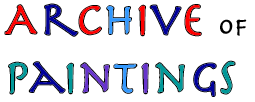 |
| . |
|
| . | |
| . | |
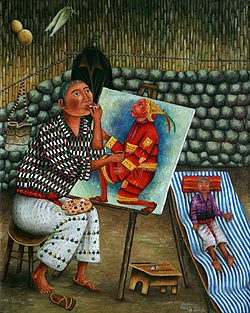 |
|
| . | |
| . | |
|
|
|
| . | |
|
|
|
| . | |
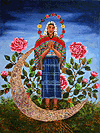 Artist
Paula Nicho Cumes of San Juan Comalapa is
undoubtedly the most important woman indigenous artist of Guatemala. Her
paintings are filled with images from her life and her dreams. Her
themes express what it means to be a woman and a Maya Indian. Artist
Paula Nicho Cumes of San Juan Comalapa is
undoubtedly the most important woman indigenous artist of Guatemala. Her
paintings are filled with images from her life and her dreams. Her
themes express what it means to be a woman and a Maya Indian. |
|
| . | |
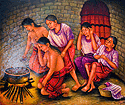 Vicenta
Puzul de Gonzalez, the wife of Mariano Gonzalez Chavajay was the
first Tz'utuhil woman oil painter. Her style of painting is virtually
indistinguishable from that of her famous husband, except that her faces
may be a bit more refined. Vicenta
Puzul de Gonzalez, the wife of Mariano Gonzalez Chavajay was the
first Tz'utuhil woman oil painter. Her style of painting is virtually
indistinguishable from that of her famous husband, except that her faces
may be a bit more refined. |
|
| . | |
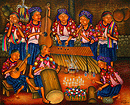 When
Maria Teodora Mendez de Gonzalez the wife of
Matias Gonzalez Chavajay began to paint she worked assisting her husband
on production work for the tourists. It was only after many years of
doing this that she started painting on her own and signing her work.
Maria Teodora, sister-in-law of Vicenta Puzul, was the second Tz'utuhil
woman to become an artist. Both Vicenta and Maria Teodora live in San
Pedro la Laguna. When
Maria Teodora Mendez de Gonzalez the wife of
Matias Gonzalez Chavajay began to paint she worked assisting her husband
on production work for the tourists. It was only after many years of
doing this that she started painting on her own and signing her work.
Maria Teodora, sister-in-law of Vicenta Puzul, was the second Tz'utuhil
woman to become an artist. Both Vicenta and Maria Teodora live in San
Pedro la Laguna. |
|
| . | |
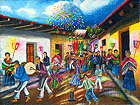 The
two granddaughters of Andres Curruchich, San Juan Comalapa's first oil
painter, were the first women to take up painting in a professions that
up to that time was entirely men. Maria Elena
Currchiche was encouraged by her father, Vicente Curruchich also a
renowed artist, to start painting. (Yes, the family relatively recently
changed the spelling of their last name.) The
two granddaughters of Andres Curruchich, San Juan Comalapa's first oil
painter, were the first women to take up painting in a professions that
up to that time was entirely men. Maria Elena
Currchiche was encouraged by her father, Vicente Curruchich also a
renowed artist, to start painting. (Yes, the family relatively recently
changed the spelling of their last name.) |
|
| .. | |
 |
|
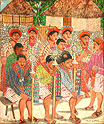 Rafael Gonzalez y Gonzalez
is called the father of Tz'utuhil Maya painting. He lived in San Pedro
when he did his first painting but then he moved to the coastal side
of the volcano to Chicacao where he continued painting. Two of his sons,
three of his grandsons and three nephews became painters. His youngest son Rafael Angel
Gonzalez still lives and paints in Chicacao. Rafael Gonzalez y Gonzalez
is called the father of Tz'utuhil Maya painting. He lived in San Pedro
when he did his first painting but then he moved to the coastal side
of the volcano to Chicacao where he continued painting. Two of his sons,
three of his grandsons and three nephews became painters. His youngest son Rafael Angel
Gonzalez still lives and paints in Chicacao. |
|
| . | |
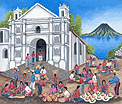 Rafael
Gonzalez y Gonzalez had three sons. Two of them moved back to San Pedro la
Laguna and the other two became painters. Jose
Antonio Gonzalez Escobar adopted a style similar to that of his father
with a special interest in the colonial church structures which were the
centers of many of the Mayan towns and still are the most interesting
architecture in most towns. Rafael
Gonzalez y Gonzalez had three sons. Two of them moved back to San Pedro la
Laguna and the other two became painters. Jose
Antonio Gonzalez Escobar adopted a style similar to that of his father
with a special interest in the colonial church structures which were the
centers of many of the Mayan towns and still are the most interesting
architecture in most towns. |
|
| . | |
 |
|
| . | |
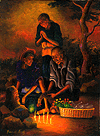 Pedro Rafael
Gonzalez Chavajay began painting in oils regularly in 1976. He is Rafael Gonzalez's
oldest grandchild and along with Mariano Gonzalez, San Pedro's longest resident oil
painter. Pedro Rafael's paintings are of the highest quality of craftmanship of any of the
Tz'utuhil painters. Pedro Rafael
Gonzalez Chavajay began painting in oils regularly in 1976. He is Rafael Gonzalez's
oldest grandchild and along with Mariano Gonzalez, San Pedro's longest resident oil
painter. Pedro Rafael's paintings are of the highest quality of craftmanship of any of the
Tz'utuhil painters. |
|
| . | |
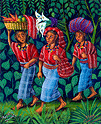 Mario
Gonzalez Chavajay is the younger brother of Pedro Rafael Gonzalez
Chavajay. Although his brother was a skilled artist, Mario learned
more or less on his own. He has been painting for twenty years, and
his work is now gaining him considerable attention. Mario
Gonzalez Chavajay is the younger brother of Pedro Rafael Gonzalez
Chavajay. Although his brother was a skilled artist, Mario learned
more or less on his own. He has been painting for twenty years, and
his work is now gaining him considerable attention. |
|
| . | |
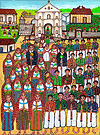 Lorenzo Gonzalez Chavajay took up
painting when he retired and continued until he died a period of about five years.
Although the art of the Tz'utuhil painters is often labelled "primitivistic,"
Lorenzo is San Pedro's only truly naive painter, painting in a style entirely of his own
devising. Lorenzo Gonzalez Chavajay took up
painting when he retired and continued until he died a period of about five years.
Although the art of the Tz'utuhil painters is often labelled "primitivistic,"
Lorenzo is San Pedro's only truly naive painter, painting in a style entirely of his own
devising. |
|
| . | |
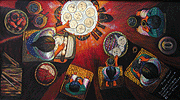 Juan
Fermin Gonzalez Morales is the oldest of three brothers who are
painters. During the time of violence he was forcibly induced into the
military. Emotionally he still suffers from the experience, but he began
painting Tz'utuhil themes from above as he saw things from the helicopters
he was in. This style, called "vista del pajaro" has become
ubiquitous with all the lesser artists painting dozens for the galleries.
His paintings and those of Abraham Batzim who made the "vista de
pajaro" style famous are the only artists who have done paintings in
this style of any importance. Juan
Fermin Gonzalez Morales is the oldest of three brothers who are
painters. During the time of violence he was forcibly induced into the
military. Emotionally he still suffers from the experience, but he began
painting Tz'utuhil themes from above as he saw things from the helicopters
he was in. This style, called "vista del pajaro" has become
ubiquitous with all the lesser artists painting dozens for the galleries.
His paintings and those of Abraham Batzim who made the "vista de
pajaro" style famous are the only artists who have done paintings in
this style of any importance. |
|
| . | |
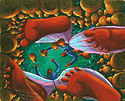 Juan
Fermin's younger brother Emilio Gonzalez Morales
has been painting since the early 1980's. He has a gallery where he sells
the paintings of the three brothers. Juan
Fermin's younger brother Emilio Gonzalez Morales
has been painting since the early 1980's. He has a gallery where he sells
the paintings of the three brothers. |
|
| . | |
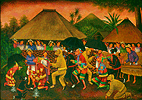 Mariano Gonzalez Chavajay is Pedro
Rafael's Gonzalez's exact contemporary starting to paint in oils only shortly after Pedro
Rafael. Mariano is the only person who might challenge Pedro Rafael to the title of being
the best artist from San Pedro. Mariano Gonzalez Chavajay is Pedro
Rafael's Gonzalez's exact contemporary starting to paint in oils only shortly after Pedro
Rafael. Mariano is the only person who might challenge Pedro Rafael to the title of being
the best artist from San Pedro. |
|
| . | |
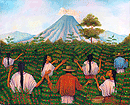 Vicenta
Puzul de Gonzalez, the wife of Mariano Gonzalez Chavajay is the first
Tz'utuhil woman painter. Her style is exactly like that of her husband so
much so that more than one artist has told me that he does the paintings
for her to sign. I have spent enough time watching her paint to know that
the painting is her own and that she in fact has worked on many
backgrounds of her husband's larger paintings. Vicenta
Puzul de Gonzalez, the wife of Mariano Gonzalez Chavajay is the first
Tz'utuhil woman painter. Her style is exactly like that of her husband so
much so that more than one artist has told me that he does the paintings
for her to sign. I have spent enough time watching her paint to know that
the painting is her own and that she in fact has worked on many
backgrounds of her husband's larger paintings. |
|
| . | |
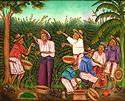 Matias Gonzalez Chavajay is Mariano's
younger brother, and it was from Mariano that he learned to paint. Matias's work is
characterized by an attention to pattern and detail combined with a child-like naivety in
depicting certain aspects of his subjects. Matias Gonzalez Chavajay is Mariano's
younger brother, and it was from Mariano that he learned to paint. Matias's work is
characterized by an attention to pattern and detail combined with a child-like naivety in
depicting certain aspects of his subjects. |
|
| . | |
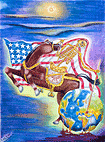 Samuel
Cumes Pop started painting in oil like the other Tz'utuhil artists,
but soon realized that with pastels he could express himself better. His
paintings are surreal and often political. Samuel was traumatized by
threats from the death squad during the time of violence during the
first half of the 1980s, and this comes out in his artwork. Samuel
Cumes Pop started painting in oil like the other Tz'utuhil artists,
but soon realized that with pastels he could express himself better. His
paintings are surreal and often political. Samuel was traumatized by
threats from the death squad during the time of violence during the
first half of the 1980s, and this comes out in his artwork. |
|
| . | |
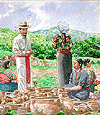 Jose Maria Gonzalez Cox, known artistically as Chema Cox, abandoned the "primitivistic" style of San
Pedro in favor of the more European style of painting practiced in Antigua Guatemala. He
changed from oil painting to watercolors giving his paintings a softer look. He has become
very proficient in painting watercolors, and is probably the best Mayan watercolorist. Jose Maria Gonzalez Cox, known artistically as Chema Cox, abandoned the "primitivistic" style of San
Pedro in favor of the more European style of painting practiced in Antigua Guatemala. He
changed from oil painting to watercolors giving his paintings a softer look. He has become
very proficient in painting watercolors, and is probably the best Mayan watercolorist. |
|
| . | |
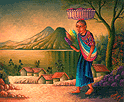 One
of the younger gereration of painters Miguel Angel
Sunu Cortez studied with Pedro Rafael Gonzalez Chavajay whose
influence is clear, none the less Miguel has his own colors and manner of
painting people. Most importantly Pedro Rafael instilled in Miguel a
strong desire to create paintings of quality. Although partly due to
inexperience Miguel is almost certainly the only Tz'utuhil artist who
paints more slowly than Pedro Rafael. One
of the younger gereration of painters Miguel Angel
Sunu Cortez studied with Pedro Rafael Gonzalez Chavajay whose
influence is clear, none the less Miguel has his own colors and manner of
painting people. Most importantly Pedro Rafael instilled in Miguel a
strong desire to create paintings of quality. Although partly due to
inexperience Miguel is almost certainly the only Tz'utuhil artist who
paints more slowly than Pedro Rafael. |
|
| . | |
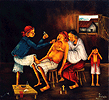 Rafael
Enrique Gonzalez Mendez is the third grandson of old Rafael Gonzalez to become a painter.
Like Pedro Rafael Gonzalez he was named for his grandfather. Rafael
Enrique Gonzalez Mendez is the third grandson of old Rafael Gonzalez to become a painter.
Like Pedro Rafael Gonzalez he was named for his grandfather. |
|
| . | |
 When
Antonio Chavajay Yojcom began painting he produced a number of quite original paintings.
He soon succumbed to the demand of the galleries in Santiago Atitlan for tourist
paintings, and now produces many small brightly colored paintings. To the right is one of
his early paintings, Mercado, Chichicastenango. When
Antonio Chavajay Yojcom began painting he produced a number of quite original paintings.
He soon succumbed to the demand of the galleries in Santiago Atitlan for tourist
paintings, and now produces many small brightly colored paintings. To the right is one of
his early paintings, Mercado, Chichicastenango. |
|
| . | |
 |
|
| . | |
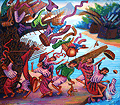 Diego Isaias
Hernandez Mendez always was an artist. The walls of his room as a
child were always covered with drawings done in pencil, pen, or colored
pencils (whatever he could get his hands on). Isaias, a jovial person,
has always been attracted to subjects he could laugh at, so he began
painting subjects such as dogs causing people to fall. He expanded this
type of theme to include natural disasters. When he won
first prize in a competition for a painting about Hurricane Mitch,
he acquired the nickname of the accident painter. Diego Isaias
Hernandez Mendez always was an artist. The walls of his room as a
child were always covered with drawings done in pencil, pen, or colored
pencils (whatever he could get his hands on). Isaias, a jovial person,
has always been attracted to subjects he could laugh at, so he began
painting subjects such as dogs causing people to fall. He expanded this
type of theme to include natural disasters. When he won
first prize in a competition for a painting about Hurricane Mitch,
he acquired the nickname of the accident painter. |
|
| . | |
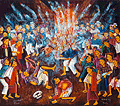 The paintings of Victor
Vasquez Temo captivate with their exhuberance and originality. In spite of his success
as an artist Victor still considers himself mainly a campesino. The paintings of Victor
Vasquez Temo captivate with their exhuberance and originality. In spite of his success
as an artist Victor still considers himself mainly a campesino. |
|
| . | |
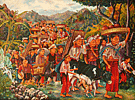 Antonio C. Ixtamer was
San Juan's second oil painter. He mostly certainly is Pedro Rafael Gonzalez's best
student. Antonio Ixtamer is a superb colorist. Many of his best paintings were a
collaboration between him and the San Pedro woodcarver Achentit. Antonio C. Ixtamer was
San Juan's second oil painter. He mostly certainly is Pedro Rafael Gonzalez's best
student. Antonio Ixtamer is a superb colorist. Many of his best paintings were a
collaboration between him and the San Pedro woodcarver Achentit. |
|
| . | |
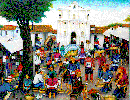 Antonio Coche Mendoza, San Juan's first painter, was one of
Mariano Gonzalez' first students. His work is the archtype for the painting style/subject
matter for the artists of San Pedro la Laguna and San Juan la Laguna. Antonio Coche has
taught many members of his family how to paint, and recently they have been taking the top
postitions in the biennial art competition put on by the cultural foundation established
by Guatemala's Paiz department store. This competition is the most important in
Guatemala and the three top paintings in each division become part of the permanent
collection in the Museo Paiz. Antonio Coche Mendoza, San Juan's first painter, was one of
Mariano Gonzalez' first students. His work is the archtype for the painting style/subject
matter for the artists of San Pedro la Laguna and San Juan la Laguna. Antonio Coche has
taught many members of his family how to paint, and recently they have been taking the top
postitions in the biennial art competition put on by the cultural foundation established
by Guatemala's Paiz department store. This competition is the most important in
Guatemala and the three top paintings in each division become part of the permanent
collection in the Museo Paiz. |
|
| . | |
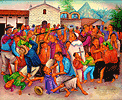 Julian
Coche Mendoza was Antonio Coche Mendoza's first student. Julian's eye for color and
composition places him among the best. Julian
Coche Mendoza was Antonio Coche Mendoza's first student. Julian's eye for color and
composition places him among the best. |
|
| . | |
 |
|
| . | |
| . |
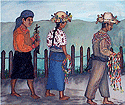 Juan Sisay was Santiago
Atitlan's first and most famous painter. Being the first coupled with his ability
soon gained him national and international recognition. His fame did not protect him
and like many people from his town during the period of violence, he was murdered by
unknown assasins in 1989. Juan Sisay was Santiago
Atitlan's first and most famous painter. Being the first coupled with his ability
soon gained him national and international recognition. His fame did not protect him
and like many people from his town during the period of violence, he was murdered by
unknown assasins in 1989.We are willing to post images of Juan Sisay's paintings. Anyone who has a Juan Sisay painting they would like to share on the web should send us a photograph along with the title date and dimensions and any other information that might be pertinent. |
| . | |
| . |
 Juan Sisay
has three sons who have become artists. They all share the same first name with their
father. They are Juan Manuel, who uses the name Manuel Sisay, Juan Diego who uses the name
Diego Sisay, and Juan Francisco who uses the name Juan Sisay, but whom we will always
refer to as Juan Francisco Sisay to differentiate from his father. They specialize in
large format, almost photographic portraits of the people of Santiago Atitlán. Juan Sisay
has three sons who have become artists. They all share the same first name with their
father. They are Juan Manuel, who uses the name Manuel Sisay, Juan Diego who uses the name
Diego Sisay, and Juan Francisco who uses the name Juan Sisay, but whom we will always
refer to as Juan Francisco Sisay to differentiate from his father. They specialize in
large format, almost photographic portraits of the people of Santiago Atitlán. |
| . | |
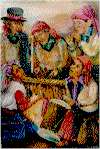 Nicolas began painting as a teenager. His first
paintings were very naive. He had one of the first art galleries in Santiago Atitlan,
which not only helped him, but many artists in San Pedro and San Juan. His works are
featured in the permanent collection of the Heard Museum in Phoenix. Nicolas began painting as a teenager. His first
paintings were very naive. He had one of the first art galleries in Santiago Atitlan,
which not only helped him, but many artists in San Pedro and San Juan. His works are
featured in the permanent collection of the Heard Museum in Phoenix. |
|
| .. | |
| . | 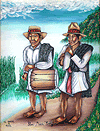 Like many
Tz'utuhil artists, Pedro Miguel Reanda began when he was a teenager. His work is
more naive than most of the artists from Santiago but it sometimes captures
something essentially uniquely Mayan. Like many
Tz'utuhil artists, Pedro Miguel Reanda began when he was a teenager. His work is
more naive than most of the artists from Santiago but it sometimes captures
something essentially uniquely Mayan. |
| . | |
 One of Santiago's finest
painters, Miguel Chavez worked as an appretice to Juan Sisay for over fifteen years. One of Santiago's finest
painters, Miguel Chavez worked as an appretice to Juan Sisay for over fifteen years. |
|
| . | |
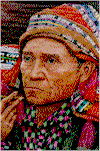 The
youngest of Nicolas Reanda Quiejú's brothers began painting in around 1988. His work
developed quickly, his depictions of people faces and hands becoming more and more
realistic. Following the lead of the Sisay brothers he began focussing mainly on large
format portraits. The
youngest of Nicolas Reanda Quiejú's brothers began painting in around 1988. His work
developed quickly, his depictions of people faces and hands becoming more and more
realistic. Following the lead of the Sisay brothers he began focussing mainly on large
format portraits. |
|
| . | |
| . |
|
|
|
To contact us write: Arte Maya Tz'utuhil, P.O. Box 40391, San
Francisco, CA 94140. Telephone: (415) 282-7654.
Email me at
All paintings and photographs Copyright © 1988–2015 Arte Maya Tz'utuhil |